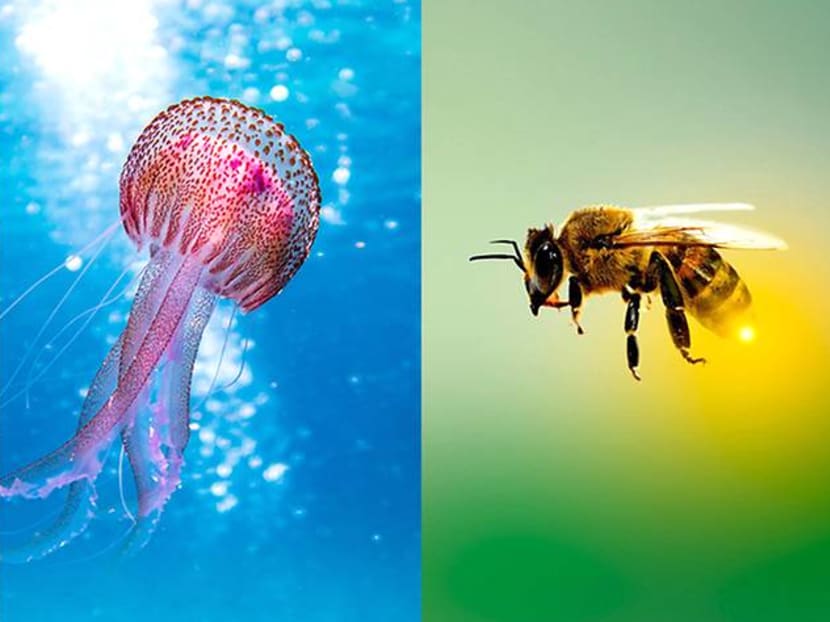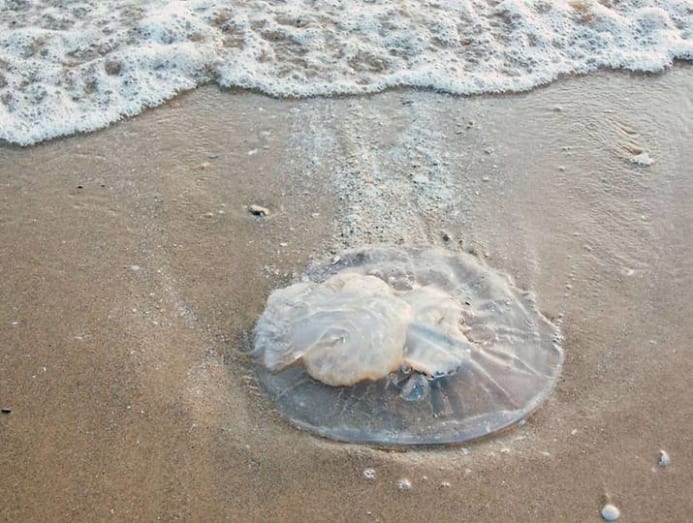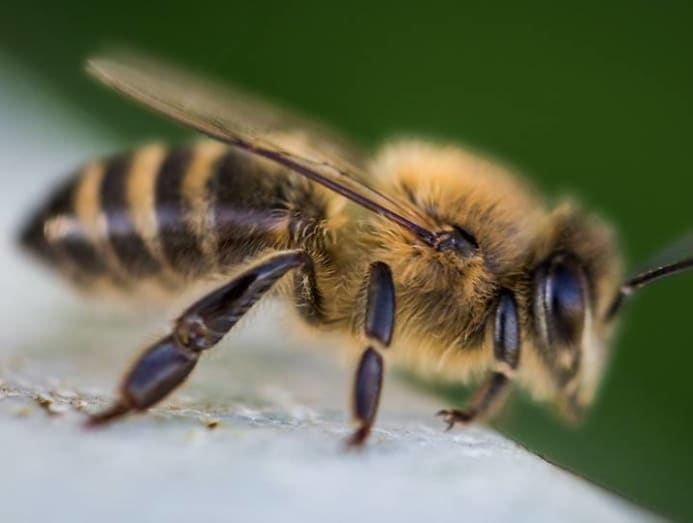First aid tips: What should you do after being stung by a stingray, jellyfish or bee?
Advertisement
Wellness
Kickoff help tips: What should yous do subsequently being stung past a stingray, jellyfish or bee?
Do you remove the sting? Do yous wash with fresh water or seawater? Find out how to bring downward the pain and swelling with these helpful tips from the experts.

The animals shown are not representative of the species that are often involved in stinging incidents. (Photos: Pixabay/Taken; Pexels/Pawel Kallisinski; Pixabay/Mariananbu)
13 April 2022 06:30AM (Updated: 08 Aug 2022 02:18PM)
Encounters with wildlife can be enriching and educational moments that remind united states just how dependent nosotros are on nature. Merely ask the many hiking converts who accept been hitting Bukit Timah Nature Reserve to walk off cabin fever and the pandemic angst, or the beach lovers who take been wading into Sentosa'south waters to cool off.
Just sometimes, these encounters tin can arm-twist painful experiences, such as the unfortunate stingray incident at Tanjong Beach or last year'south jellyfish episode at Palawan Embankment.
"Allergic reactions are ane of the most feared complications arising from whatever sting," said Dr Jonathan Chong from DTAP Clinic. Signs of an allergic reaction include a generalised rash over the body, difficulty breathing, and swelling of the face up, eyes and neck, he said.
These signs can develop apace over the course of a few minutes and can be lethal, he added, referring to the life-threatening status known as anaphylaxis.
READ: My real-life experience with jellyfish stings: What worked and what didn't
However, if the symptoms are balmy and self-limiting, and there are no stingers in the skin, said Dr Chong, self-treatment is possible.
How, and then, practise y'all care for such wounds? Exercise you endeavor to remove the stinger? And what is the best mode to minimise the hurting? Here's what to do if you accidentally get on nature's incorrect side and become stung.
STINGRAY STING
The impairment: The barb near the base of a stingray's tail is similar a sheathed, serrated blade with venom glands. Co-ordinate to a report on injuries by marine creatures published in the Singapore Medical Periodical (SMJ), when the barb pierces flesh, the sheath breaks, allowing venom to enter the wound.
The venom causes blood vessels to constrict and the resulting poor blood circulation and lack of oxygen tin atomic number 82 to the skin turning blue and the affected tissues to die.
Explained Dr Chong: "Stings from stingrays will oft result in a combination of a puncture wound and a cut in the skin. The pain can persist for hours, is often severe and can radiate up the affected limb. There is usually also profuse bleeding from the wound".
In that location may also be symptoms like nausea, vomiting, diarrhoea, common cold sweat, fainting or seizures, according to Dr Keith Ho, the chief of the Urgent Care Eye at Alexandra Hospital.
In our practice, bee stings are far more than usually encountered than stingray or jellyfish stings.
First assistance action:The first affair to do is to get the victim out of the h2o, and either phone call for the lifeguard or an ambulance, said Dr Chong. Check that the victim'due south airway is not blocked and he is withal breathing; otherwise, a trained person should perform cardiopulmonary resuscitation or CPR.
"Visible, superficial stingray barbs or debris can exist removed with a pair of tweezers or by manus," said Dr Chong. However, if it'due south a deep, puncture wound, especially in the neck, chest or belly, practice non attempt to remove the barb but let the emergency medical team handle it, he cautioned.

To reduce the pain, Dr Chong recommended immersing the affected limb in hot h2o (40 to 45 degrees Celsius). "A hot shower is as well possible," he said. If hot water is non available, utilise a oestrus pack on the wound. Otherwise, use a cold pack or make one past wrapping ice in a dry out plastic bag instead.
Chances for self-handling are depression, according to Dr Ho, as stingray wounds by and large crave a tetanus shot (if yours isn't upward to date) – and an inspection of the injured area for any foreign body, non-viable tissue and severity of infection.
JELLYFISH STING
The damage: Jellyfishes' gelatinous domes are unremarkably harmless but affect their trailing tentacles and you tin can look a world of pain. The burning, stinging sensation that results is acquired by several million stinging cells launching spirally-coiled threads – each ending with a toxin-containing barb – into your skin when touched, said Dr Ho.

In fact, this very function of the stinging cells does not cease fifty-fifty when the jellyfish is washed upward on the beach – or even when its tentacles are nonetheless attached to your skin. This is why, according to the SMJ report, you should not scratch, rub or launder the affected area with fresh h2o as it may activate undischarged stingers and crusade farther impairment.
Outset aid action: Assist the person out of the water immediately and call 995, advised the National Parks Board (NParks). While waiting for medical help to go far, keep the person calm and nevertheless to minimise the tentacles from further discharging venom.
To reduce the pain, apply vinegar directly to the wound, either by dousing or spraying, for about 30 seconds to conciliate the stingers, said Dr Chong. NParks noted that if the vinegar worsens the pain (non-box jellyfish stings may go more painful), stop using information technology and just affluent with seawater. But practise not apply fresh water, urine or other substances.

Afterwards that, proceed to pluck visible tentacles off the skin and rinse the expanse with seawater, said Dr Chong. Exercise not rub the sting site to get the tentacles off as that may worsen the pain. A give-and-take of caution: If y'all don't have tweezers and are picking the tentacles off with your bare fingers, you may experience a low-cal stinging awareness. Rinse your easily with seawater when you are done.
BEE STING
The damage: "In our practise, bee stings are far more than unremarkably encountered than stingray or jellyfish stings," said Dr Chong, who sees two to four patients with bee stings a week, especially younger children.
If you are not allergic to bee stings, the meet is really more fatal for the bee – if it'south a dear bee – than for you. That'due south because love bees take barbed stingers that get stuck in your skin afterwards stinging y'all. To get away, the bee has to disembowel itself and dies. Wasps, hornets and other bees are spared this fate as their stingers are not barbed – which as well ways they can sting multiple times.

The venom, which contains components that cause hurting, itching, allergic reactions and impairment to the tissues, is released in the outset few seconds of stinging. You go a red, painful and itchy crash-land; or anaphylaxis if you are allergic to the venom, said Dr Ho.
"About 10 per cent of people may have a stronger reaction, developing more pronounced redness and swelling over the sting site that gradually enlarges over one to 2 days," said Dr Chong. "This tin can take up to 10 days to subside."
Yet, Dr Ho noted that mostly, you can cocky-treat bee stings "if there are only a few stings, the local reaction is small, and the pain or itch minimal". "Medical attention is generally required if there are multiple stings (risks of kidney and/or liver failure, or muscle breakdown) or signs of anaphylaxis (rash, hoarse voice, abdominal symptoms, breathing difficulties and/or fainting)."
Get-go aid action: If a stinger is left behind in the wound, scrape it out past using the border of a credit card equally presently as possible, advised Dr Ho.
To reduce the pain, Dr Chong recommended washing the affected area with soap and water, and applying a common cold pack to the sting site. "If the sting is on an arm or a leg, elevation of the affected limb may aid to reduce pain and swelling as well."
Then, detect the victim for signs of serious allergic reactions, which would crave firsthand medical attending.
Recent Searches
Trending Topics
Source: https://cnalifestyle.channelnewsasia.com/wellness/first-aid-stingray-jellyfish-bee-stings-237796

Post a Comment for "First aid tips: What should you do after being stung by a stingray, jellyfish or bee?"